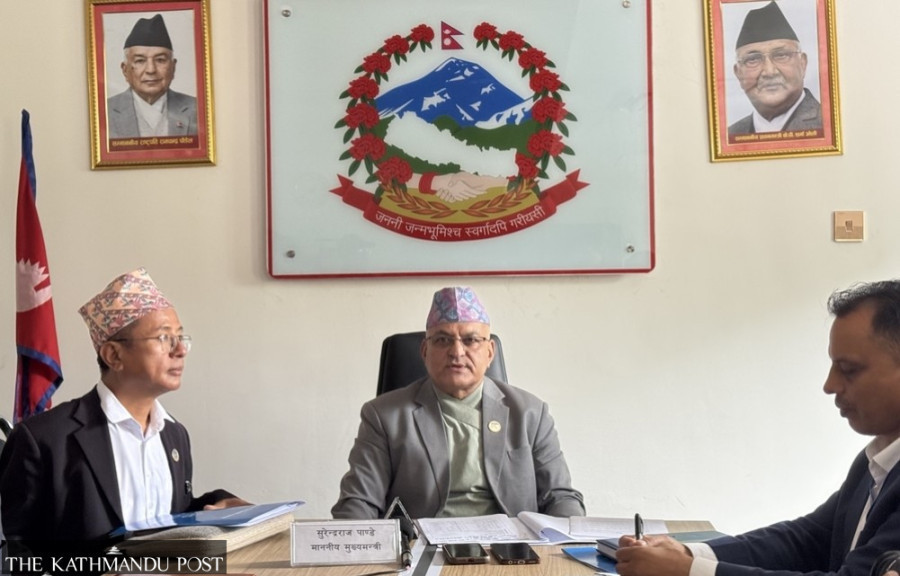Columns
A blueprint for reform
Gandaki Province shows that federalism can be both affordable and effective with the right actions.
Khim Lal Devkota
Many argue that federalism in Nepal is expensive. Yet, this criticism often comes from those who prefer a centralised state, members of the educated elite, or individuals with feudal mindsets. These critics are fully capable of explaining why federalism was introduced and how its costs could be managed efficiently, yet they frequently remain silent on solutions. Instead, they repeat phrases like ‘federalism is costly’ or ‘provinces are unnecessary’ without examining the evidence.
What is often overlooked is that provincial expenditures constitute less than 10 percent of total spending within the three-tiered state structure. Federalism has brought government services closer to the people. Citizens from the far eastern and far western regions no longer need to travel to Kathmandu for routine administrative and fiscal matters, and most services are now available within their provinces or local governments. High-ranking officials who rarely left Kathmandu in the past are now actively engaged at the subnational government level, enhancing governance nationwide. Fiscal resources and authority, previously centralised, are now constitutionally shared across subnational governments.
In practical terms, local governments that once struggled to prepare budgets as small as Rs2 million now manage budgets averaging Rs800 million, demonstrating unprecedented fiscal empowerment and administrative responsibility. On average, local governments that previously received only about Rs1.0–Rs1.5 million in unconditional grants are now receiving nearly Rs120 million through fiscal equalisation grants. This demonstrates that federalism strengthens governance and development when effectively implemented.
Critics labelling federalism as ‘expensive’ often ignore context. Various studies suggest that 10–12 ministries, around two dozen departments and 20,000–22,000 staff would suffice at the federal level. In reality, there are now 22 ministries, approximately five dozen departments and 51,000 employees. However, the decentralisation of resources, personnel and institutions to subnational levels has brought services closer to citizens and accelerated development, thereby strengthening accountability and responsibility.
The core issue is not whether federalism is inherently costly. The challenge lies in downsizing remnants of a centralised state, ensuring the implementation of constitutional rights for provinces and local governments. Similarly, creating an efficient and responsive administration is another major challenge. Concerns regarding the multiplication of provincial institutions are valid and require rationalisation. Likewise, the number of provincial ministers has drawn criticism. As Chairperson of the National Assembly’s Special Committee on Federalism Implementation, the committee recommended reducing the number of provincial ministers from 20 percent of assembly members to 10 percent. The committee also suggested halving the number of ministries, departments and employees at the federal level.
Other experts echo this view. They emphasise the need for administrative reforms and expenditure rationalisation. Despite repeated recommendations from parliamentary committees and government reports, implementation has been limited, highlighting a persistent gap between policy and practice.
Encouragingly, Gandaki Province has taken a significant step forward. The provincial government recently approved a comprehensive administrative restructuring, the most extensive since the introduction of federalism. The Gandaki Provincial government’s cabinet meeting held on Shrawan 26 (11 August) abolished nine offices, merged 32 into 17 and reduced 185 positions. These measures are expected to save Rs400–Rs500 million annually while improving service delivery and operational efficiency. Chief Minister Surendra Raj Pandey emphasised that the reforms aim to reduce costs without compromising service quality or efficiency.
When I asked him how he managed the process and whether any resistance arose from staff, he explained that meaningful reform is possible when work is carried out selflessly—without favouritism, greed, or personal interests—and without weighing whether someone is a leader’s associate, friend, or relative. He added that while significant progress has been made, much more remains to achieve comprehensive improvement.
However, on August 18, employee trade unions submitted a joint 14-point demand letter to the Principal Secretary of the Gandaki Provincial Government, criticising the decision to abolish certain offices and cut staff positions. Yet, if the political leadership remains determined and optimistic, such demands will have little impact. Nepal’s earlier experiments with decentralisation largely failed because of such employees.
The first restructuring phase eliminated seven directorates, including Tourism; Industry, Commerce and Consumer Welfare; Agriculture; Livestock and Fisheries; Infrastructure; Forest; Education; and Health, along with two regional health centres. Responsibilities have been reassigned to branches or divisions within the respective ministries. Social development offices were consolidated from 11 to six, and technical units such as crop protection laboratories, soil and fertiliser testing facilities and seed quality control centres now operate as single provincial laboratories.
The restructuring also eliminated 185 positions, including 41 officer-level, 96 assistant-level and 48 other roles. The Health Ministry experienced the largest reduction with 57 posts cut, followed by Agriculture and Land Management (25), Social Development (24), Forest and Environment (22), Energy and Water Resources (14), Infrastructure and Transport (14), the Provincial Assembly Secretariat (14), and the Chief Minister’s Office (13). Eliminated positions in the Health Ministry included under-secretaries, section officers, accounts officers and nursing staff. These reductions are expected to generate long-term savings in salaries and pensions, medical allowances and other benefits.
The provincial government has assured that no permanent staff will lose jobs. Career development opportunities remain intact, and the newly introduced ‘Employee Transfer and Deputation Guidelines, 2025’ enforce merit-based rotations, limit consecutive postings and reduce politically influenced transfers, strengthening institutional capacity.
The administrative overhaul is being implemented in three stages: First, office mergers, eliminations and staff reductions; second, a review of organisational structures for further optimisation; and third, an evaluation of service delivery effectiveness before final adjustments. Consultations with employee unions preceded the announcement to ensure smooth implementation and maintain workforce stability.
This reform positions Gandaki Province as a potential model for both other provinces and the federal government. Since the introduction of federalism, provincial bureaucracies have faced criticism for being top-heavy, consuming large budget shares without corresponding improvements in public service. Gandaki demonstrates that fiscal responsibility and effective governance can coexist by streamlining structures, reducing redundancies and ensuring staff accountability.
However, administrative reform alone is not enough. Broader economic impact requires creating private-sector opportunities and generating employment. Gandaki Province, with its robust education and health systems, well-developed road networks, hydropower potential and commercial centres, is well-positioned to attract investment and stimulate job creation. By linking structural reform with economic development, Gandaki is offering a model for more responsive and accountable governance while also addressing broader development challenges.
Gandaki Province’s initiative is more than just reducing offices or positions. It represents the creation of a sustainable, transparent and effective provincial governance model that enhances service delivery, strengthens accountability and ensures efficient use of public resources. By demonstrating that administrative efficiency and fiscal prudence can be achieved simultaneously, Gandaki Province provides a blueprint for reform—one that other provinces and the federal government can emulate to build a functional, balanced federal system that truly serves citizens. Other provinces and the federal government now have a tested model to follow.




 18.12°C Kathmandu
18.12°C Kathmandu















